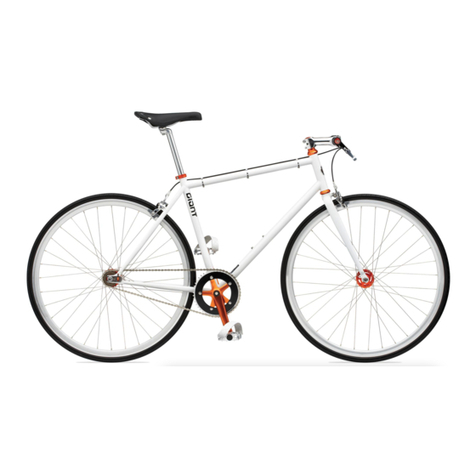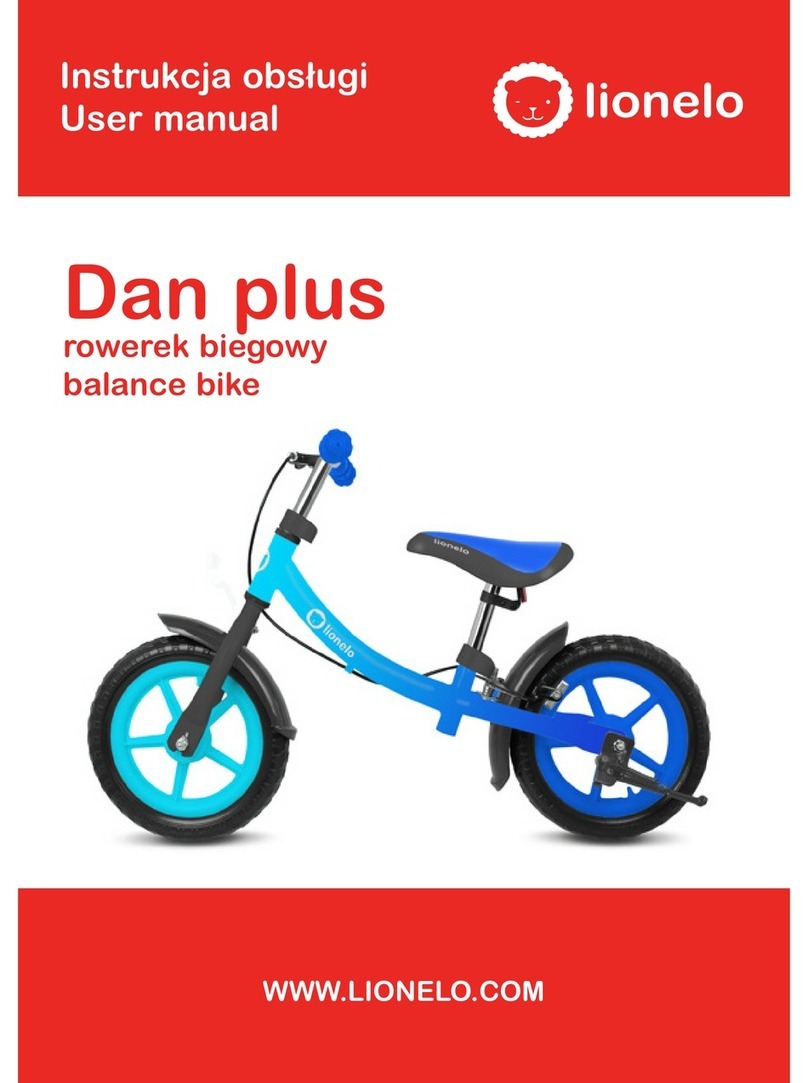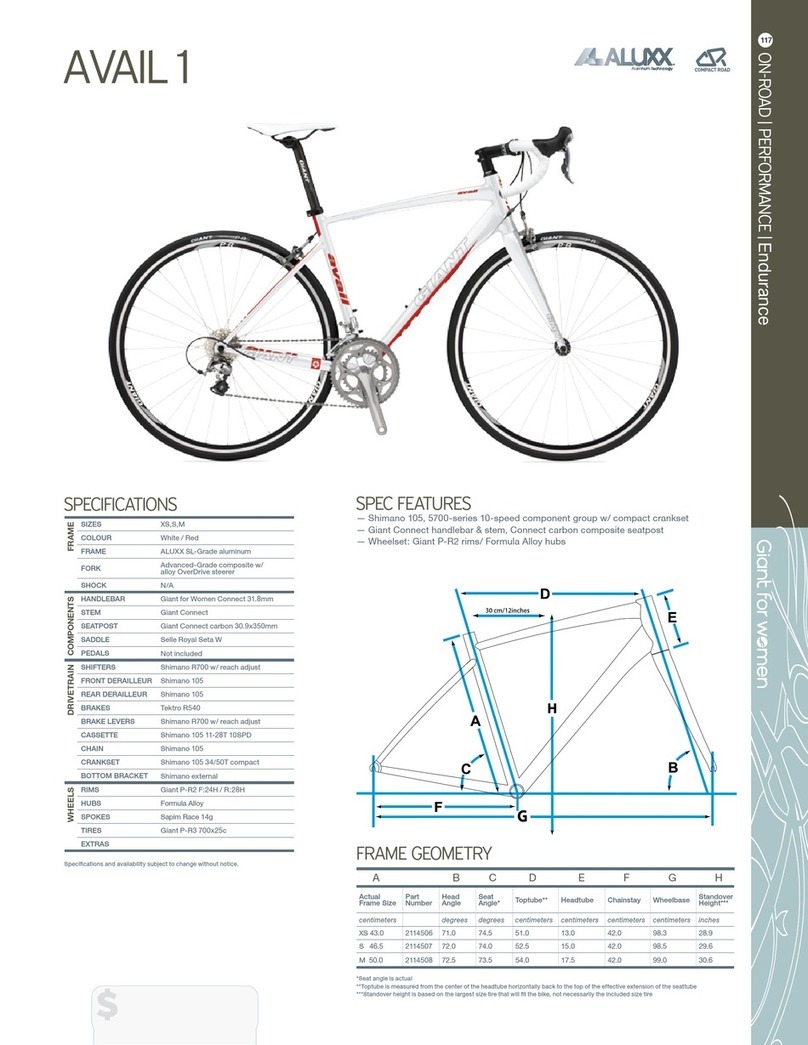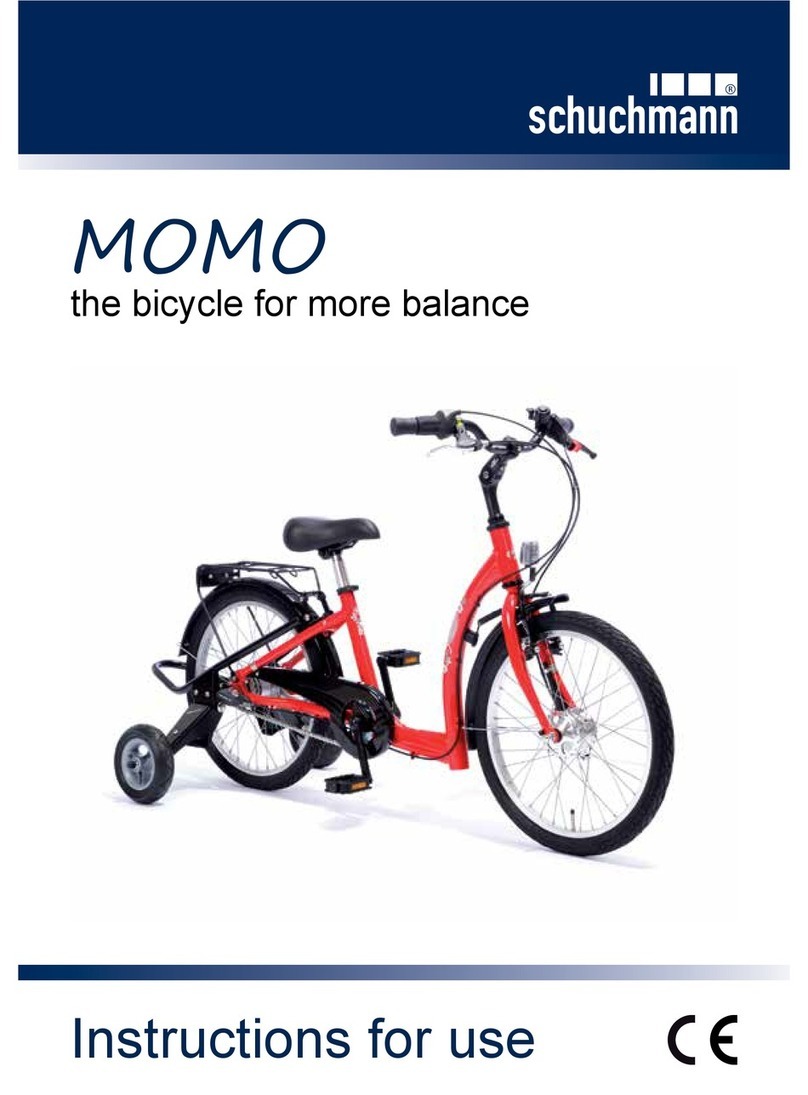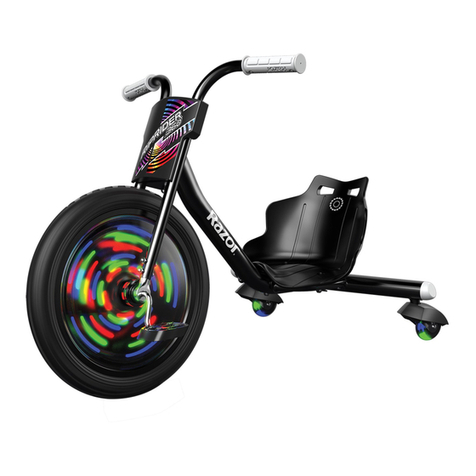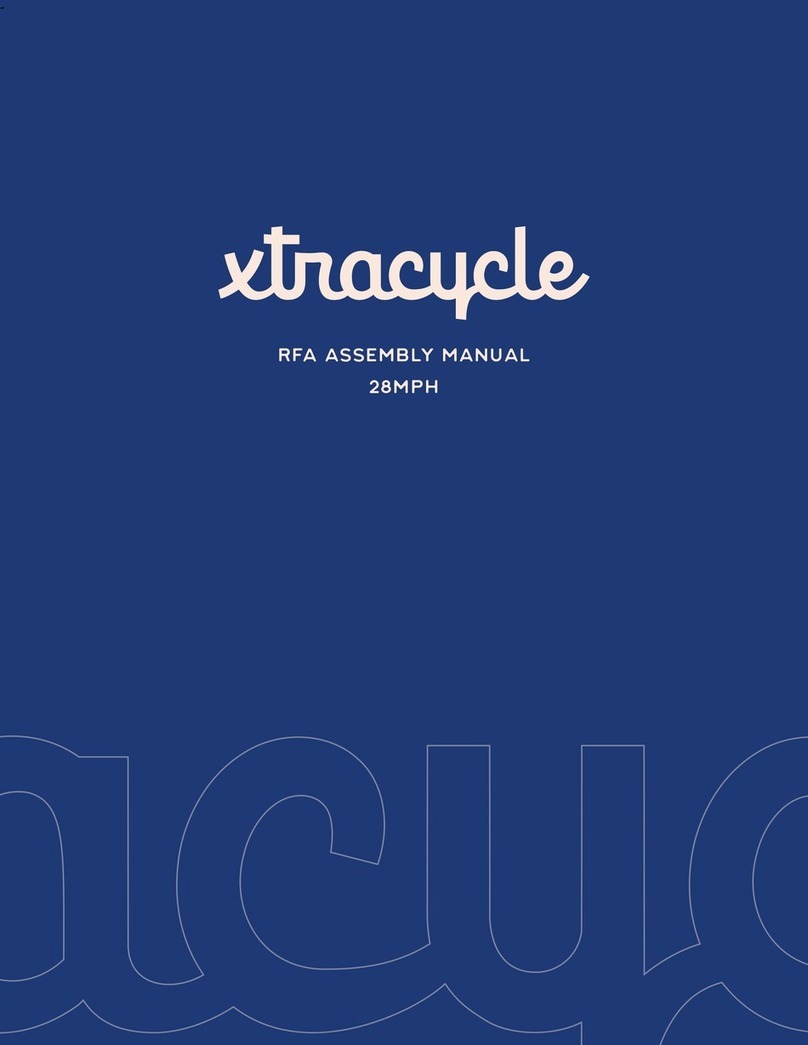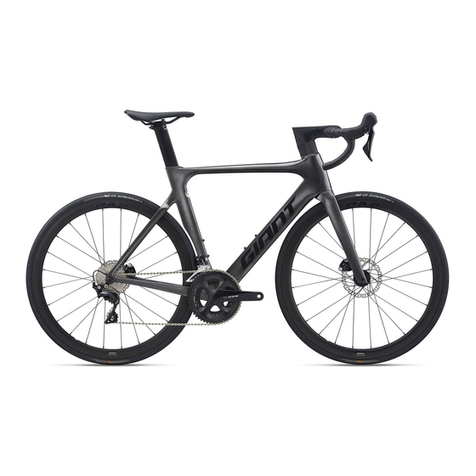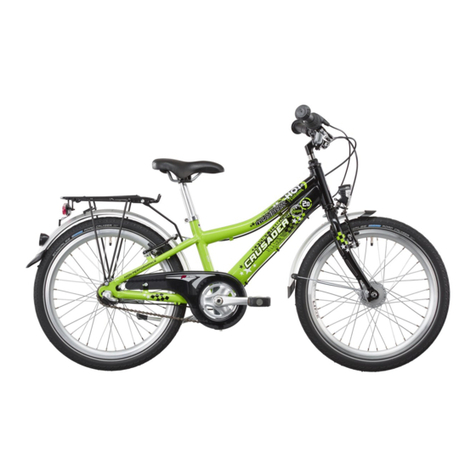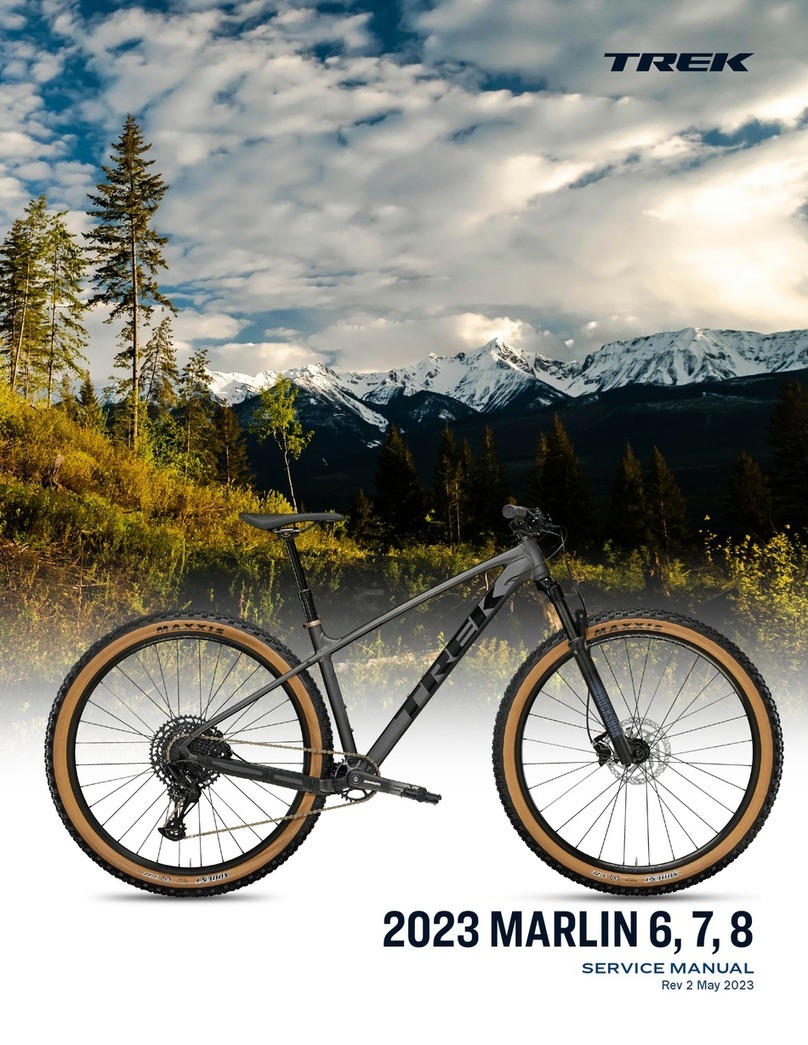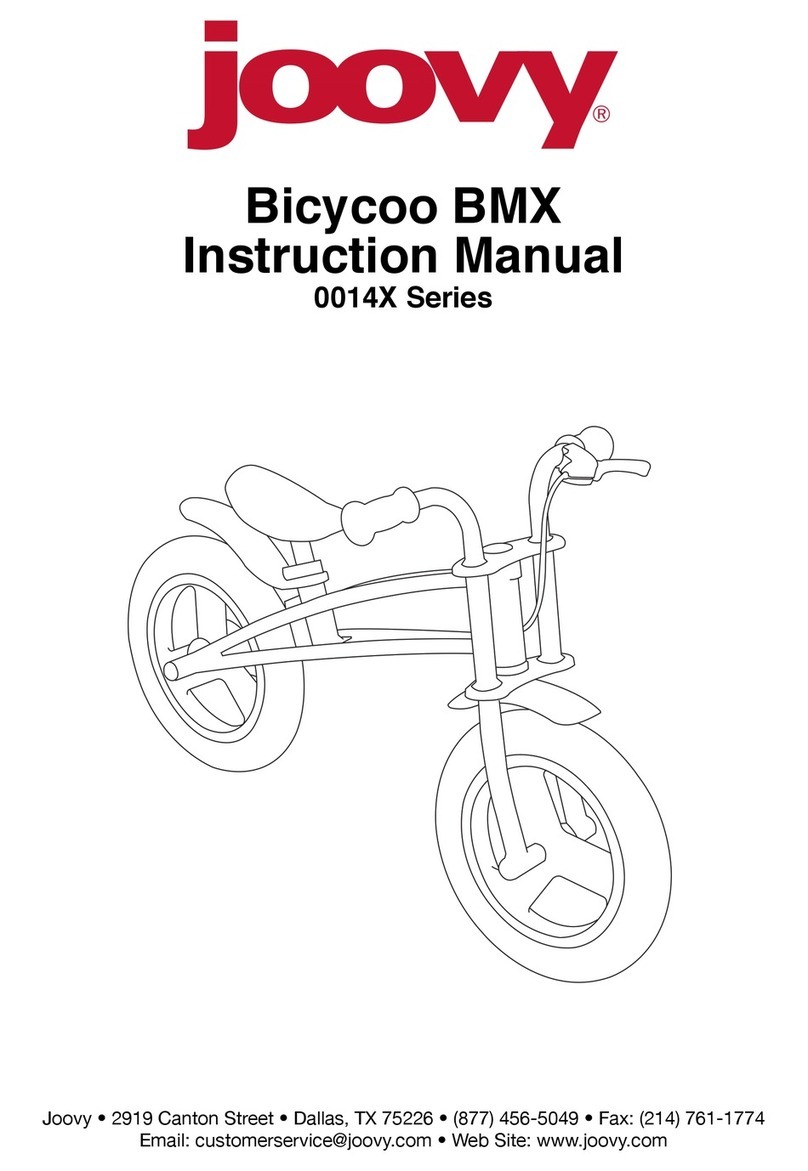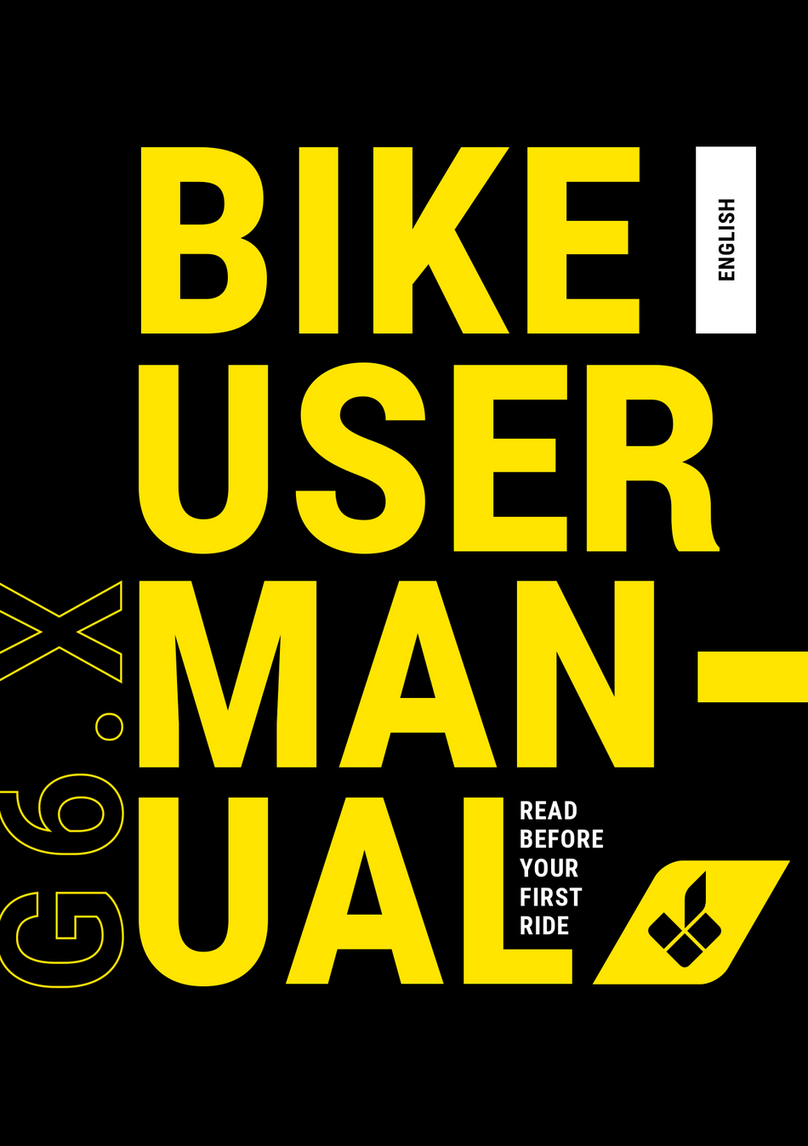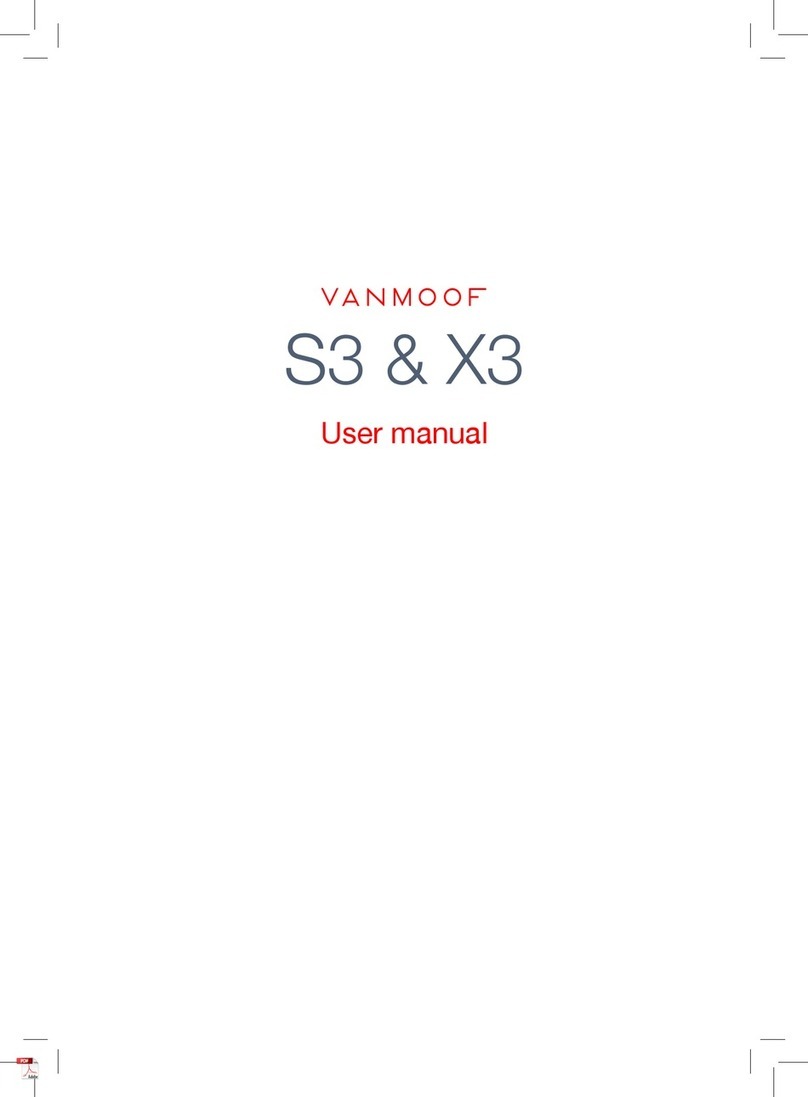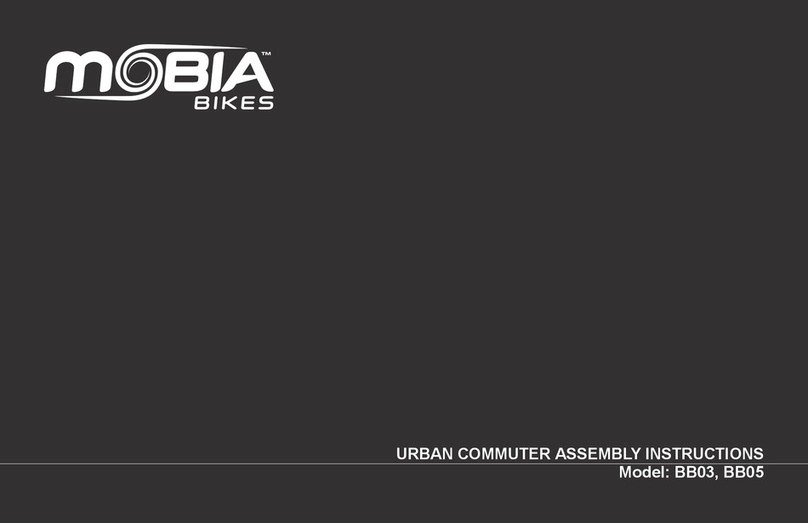Hercules Intero I-R8 ZR 28" 8G Series User manual

Panasonic Pedelecs
Intero I-R8 ZR 28" 8G, Intero I-8 ZR 28" 8G
20-Q-0055, 20-Q-0056
MY20H08-2 • 1.0 • 30. August 2019
TRANSLATION OF THE ORIGINAL OPERATING INSTRUCTIONS
IMPORTANT
READ CAREFULLY BEFORE USE
KEEP SAFE TO CONSULT AT A LATER DATE

MY20H08-2_1.0_27.08.2019 2
Contents
Contents
1 About these operating instructions 5
1.1 Manufacturer 5
1.2 Type number and model 5
1.3 Identifying the operating instructions 5
1.4 Laws, standards and directives 6
1.5 Subject to change 6
1.6 Language 6
1.7 For your safety 6
1.7.1 Instruction, training and customer service 6
1.7.2 Basic safety instructions 6
1.7.3 Warnings 6
1.7.4 Safety markings 7
1.8 For your information 7
1.8.1 Information on the nameplate 7
1.9 Nameplate 8
2 Safety 9
2.1 General warnings 9
2.2 Toxic substances 10
2.3 Requirements for the rider 11
2.4 Vulnerable groups 12
2.5 Data privacy 12
2.6 Personal protective equipment 12
2.7 Safety markings and safety instructions 12
2.8 Emergency 12
2.8.1 What to do in an emergency 12
2.8.2 First aid treatment 13
2.8.3 Fighting fire 13
2.8.4 Leaking fluids 13
2.8.4.1 Brake fluid 13
2.8.4.2 Oils and lubricants from the fork 13
2.8.4.3 Oils and lubricants from the rear frame
damper 13
3Overview 14
3.1 Description 15
3.1.1 Wheel and suspension 15
3.1.1.1 Valve 15
3.1.2 Suspension 15
3.1.2.1 Steel suspension fork structure 16
3.1.2.2 Air suspension fork structure 16
3.1.2.3 Structure of the FOX rear frame damper 17
3.1.2.4 Structure of the Suntour rear frame
damper 17
3.1.3 Brake system 17
3.1.3.1 Rim brake 17
3.1.3.2 Disc brake 18
3.1.3.3 Back-pedal brake 18
3.1.4 Electric drive system 19
3.1.5 Rechargeable battery 20
3.1.6 Riding light 20
3.1.7 Control panel 20
3.1.8 Display 21
3.2 Proper use 22
3.3 Improper use 23
3.4 Technical data 24
3.4.1 Pedelec 24
3.4.2 Panasonic GX Power Motor 24
3.4.3 Panasonic TP-PCT rechargeable
battery 24
3.4.4 USB port 24
3.4.5 Display 24
3.4.6 Control device 24
3.4.7 Emissions 24
3.4.8 Tightening torque 24
3.5 Description of controls and screens 25
3.5.1 Handlebars 25
3.5.2 Display 25
3.5.2.1 Current speed 25
3.5.2.2 Battery level indicator 25
3.5.2.3 Level of assistance 26
3.5.2.4 Function display 26
3.5.2.5 Journey information 26
3.5.2.6 System settings and data 26
3.5.2.7 System message 26
3.5.3 Control panel 26
3.6 Environmental requirements 27
4 Transporting and storing 29
4.1 Physical transport characteristics 29
4.1.1 Dimensions during transportation 29
4.1.2 Transport weight 29
4.1.3 Designated handles/lifting points 29
4.2 Transporting 29
4.2.1 Transporting the battery 30
4.2.2 Shipping the battery 30
4.2.3 Using the brake transport securing
system 30
4.3 Storing 30
4.3.1 Break in operation 31
4.3.1.1 Preparing a break in operation 31
4.3.1.2 Taking out of operation 31
5 Assembly 32
5.1 Required tools 32
5.2 Unpacking 32
5.2.1 Scope of delivery 32
5.3 Commissioning 33
5.3.1 Checking the battery 33
5.3.2 Initial use of the display 33
5.3.3 Installing the wheel in the Suntour fork 34
5.3.3.1 Installing the wheel with screw-on axle
(15 mm) 34
5.3.3.2 Installing the wheel with screw-on axle
(20 mm) 35
5.3.3.3 Installing the wheel with a quick release
axle 35

MY20H08-2_1.0_27.08.2019 3
Contents
5.3.4 Installing the wheel with a quick release 37
5.3.5 Installing the wheel in the FOX fork 38
5.3.5.1 Wheel with quick release (15 mm) 38
5.3.5.2 Adjusting the FOX quick release 38
5.3.5.3 Installing the wheel with Kabolt axles 39
5.3.5.4 Checking the stem and handlebars 39
5.3.6 Pedelec sale 39
6Operation 40
6.1 Risks and hazards 40
6.1.1 Tips for a greater range 41
6.1.2 Personal protective equipment 41
6.2 Error messages 42
6.2.1 Error message display 42
6.3 Instruction and customer service 43
6.4 Adjusting the pedelec 43
6.4.1 Adjusting the saddle 43
6.4.1.1 Adjusting the saddle tilt 43
6.4.1.2 Determining the seat height 43
6.4.1.3 Adjusting the seat height with quick
release 44
6.4.1.4 Height-adjustable seat post 44
6.4.1.5 Adjusting the seat position 45
6.4.2 Adjusting the handlebars 45
6.4.2.1 Adjusting the stem 45
6.4.2.2 Adjusting the height of the handlebars 45
6.4.2.3 Adjusting the quick release clamping
force 46
6.4.3 Adjusting the brake lever 46
6.4.3.1 Adjusting the pressure point on a
Magura brake lever 46
6.4.3.2 Adjusting the grip distance 46
6.4.3.3 Adjusting the grip distance on a
Magura brake lever 47
6.4.4 Adjusting Suntour fork 47
6.4.4.1 Adjusting the negative deflection 47
6.4.4.2 Adjusting the steel suspension fork
negative deflection 48
6.4.4.3 Adjusting the air suspension fork
negative deflection 48
6.4.4.4 Adjusting the air suspension fork
rebound 49
6.4.5 Adjusting the FOX fork 49
6.4.5.1 Adjusting the negative deflection 49
6.4.5.2 Adjusting the rebound 50
6.4.6 Setting the Suntour rear frame damper 51
6.4.6.1 Adjusting the negative deflection 51
6.4.6.2 Adjusting the rebound 51
6.4.6.3 Setting the compression 51
6.4.7 Setting the FOX rear frame damper 52
6.4.7.1 Adjusting the negative deflection 52
6.4.7.2 Adjusting the rebound 52
6.4.8 Retracting the brake linings 53
6.5 Accessories 54
6.5.1 Child seat 54
6.5.2 Bicycle trailers 55
6.5.3 Pannier rack 55
6.6 Before each ride 56
6.7 Check list before each ride 56
6.8 Using the kickstand 57
6.8.1 Raising the kickstand 57
6.8.1.1 Parking the pedelec 57
6.9 Using the pannier rack 57
6.10 Rechargeable battery 58
6.10.1 Removing the battery 59
6.10.2 Inserting the battery 59
6.10.3 Charging the battery 59
6.10.4 Waking the battery 60
6.11 Electric drive system 61
6.11.1 Switching on the electric drive system 61
6.11.2 Switching off the drive system 61
6.12 Display 62
6.12.1 Removing and attaching the display 62
6.12.1.1 Attaching the display 62
6.12.2 Securing the display against removal 62
6.12.2.1 Removing the display 63
6.12.3 Using the USB port 63
6.12.4 Using the push assist system 64
6.12.5 Using the riding light 64
6.12.6 Using night mode 64
6.12.7 Selecting the level of assistance 64
6.12.8 Journey information 65
6.12.8.1 Changing the displayed journey
information 65
6.12.8.2 Resetting the journey information 65
6.12.9 Changing the system settings 65
6.12.9.1 Changing the language 65
6.12.9.2 Changing the display contrast 65
6.12.9.3 Changing the brightness 66
6.12.9.4 Changing the unit of measure for speed 66
6.12.9.5 Setting information on the tyre size 66
6.12.9.6 Changing the distance travelled 66
6.12.9.7 Setting the clock 67
6.12.10 Replacing the battery 67
6.13 Brake 68
6.13.1 Using the brake lever 69
6.13.2 Using the back-pedal brake 70
6.14 Suspension and damping 70
6.14.1 Adjusting the compression of the
Fox fork 70
6.14.2 Adjusting the compression of the
Fox damper 70
6.14.3 Adjusting the compression of the
Suntour fork 71

MY20H08-2_1.0_27.08.2019 4
Contents
6.14.4 Adjusting the compression of a
Suntour damper 71
6.14.5 Adjusting the rebound in a Rock
Shox damper 71
6.14.6 Adjusting the compression in a
Rock Shox damper 72
6.15 Gear shift 72
6.15.1 Selecting gears 72
6.15.2 Using the hub gear 73
7 Cleaning and servicing 74
7.1 Cleaning after each ride 74
7.1.1 Cleaning the suspension fork 74
7.1.2 Cleaning the rear frame damper 74
7.1.3 Cleaning the pedals 74
7.2 Basic cleaning 75
7.2.1 Cleaning the frame 75
7.2.2 Cleaning the stem 75
7.2.3 Cleaning the wheel 75
7.2.4 Cleaning the drive elements 75
7.2.5 Cleaning the rear frame damper 76
7.2.6 Cleaning the chain 76
7.2.7 Cleaning the battery 76
7.2.8 Cleaning the display 76
7.2.9 Cleaning the drive unit 76
7.2.10 Cleaning the brake 77
7.3 Servicing 77
7.3.1 Servicing the frame 77
7.3.2 Servicing the stem 77
7.3.3 Servicing the fork 77
7.3.4 Servicing the drive elements 77
7.3.5 Servicing the pedals 77
7.3.6 Servicing the chain 77
7.3.7 Servicing the drive elements 77
7.4 Maintenance 77
7.4.1 Wheel 77
7.4.1.1 Checking the tyres 78
7.4.1.2 Checking the rims 78
7.4.1.3 Checking and adjusting the tyre
pressure – Dunlop valve 78
7.4.1.4 Checking and adjusting the tyre
pressure – presta valve 78
7.4.1.5 Checking and adjusting the tyre
pressure – Schrader valve 79
7.4.2 Brake system 79
7.4.3 Checking the brake linings for wear 79
7.4.4 Checking the pressure point 79
7.4.5 Checking the brake discs for wear 79
7.4.6 Electrical cables and brake cables 79
7.4.7 Gear shift 79
7.4.8 Stem 80
7.4.9 USB port 80
7.4.10 Checking the belt and chain tension 80
8 Maintenance 81
8.1 Axle with quick release 82
8.1.1 Checking the quick release 82
8.2 Adjusting the gear shift 82
8.2.1 Cable-operated gear shift,
single-cable 83
8.2.2 Cable-operated gear shift,
dual-cable 83
8.2.3 Cable-operated twist grip,
dual-cable 83
9 Troubleshooting, fault clearance
and repair 84
9.1 Troubleshooting and fault clearance 84
9.1.1 The drive system or display do not
start up 84
9.1.2 Error messages 84
9.2 Switching on 85
9.3 Assistance function 85
9.4 Rechargeable battery 86
9.5 Lighting 87
9.6 Display 88
9.7 Miscellaneous 88
9.8 Repair 89
9.8.1 Use original parts and lubricants only 89
9.8.2 Replacing the lighting 89
9.8.3 Adjusting the headlight 89
10 Recycling and disposal 90
11 Documents 91
11.1 Parts list 91
11.2 Assembly report 92
11.3 Maintenance log 94
12 Keyword index 97
13 Glossary 98
13.1 Abbreviations 100
13.2 Simplified terms 100
I. EC declaration of conformity 101

MY20H08-2_1.0_30.08.2019 5
About these operating instructions
1 About these operating instructions
Thank you for your trust!
HERCULES pedelecs are premium quality
bicycles. You have made an excellent choice.
Your specialist dealer will provide you with
guidance and assemble your product. Your
specialist dealer will also be happy to assist you in
the future whether you require maintenance,
conversion or repair.
You receive these operating instructions with your
new pedelec. Please take time to become familiar
with your new pedelec and follow the tips and
suggestions in the operating instructions. They
will help you to enjoy your HERCULES pedelec for
a long time to come. We hope you have fun and
wish you well on all of your rides!
These operating instructions are designed for the
rider and the operator to ensure that non-
professionals can use the pedelec safely.
Download the operating
instructions onto your phone at
the following link, so that you
can use them when you are out
riding:
https://www.hercules-bikes.de/
de/de/index/downloads.html
1.1 Manufacturer
The pedelec manufacturer is:
HERCULES GMBH
Longericher Straße 2
50739 Köln, Germany
Tel.: +49 4471 18735 0
Fax: +49 4471 18735 29
E-mail: [email protected]
Internet: www.hercules-bikes.de
1.2 Type number and model
The operating instructions are an integral part of
pedelecs with the following type numbers:
1.3 Identifying the operating
instructions
You will find the operating instructions
identification number at the bottom left-hand side
of each page. The identification number consists
of the document number, the version number and
the release date.
Notice
The operating instructions are not a substitute for
personal instruction by the supplying specialist
dealer.
The operating instructions are an integral part of
the pedelec. Therefore, if it is re-sold at a later
time, they must be handed over to the subsequent
owner.
Instructions for the specialist dealer are
highlighted in grey and marked with a symbol.
Specialist dealers have specialist training and
qualifications and are thus able to identify risks
and prevent hazards which may arise during
maintenance, servicing and repairs. Information
for specialist staff does not require non-
professionals to take any action.
Type no. Model Pedelec type
20-Q-0055 Intero I-R8 ZR 28"
600Wh 8G
City and trekking
bicycle
20-Q-0055 Intero I-R8 ZR 28"
500Wh 8G
City and trekking
bicycle
20-Q-0055 Intero I-R8 ZR 28"
400Wh 8G
City and trekking
bicycle
20-Q-0056 Intero I-8 ZR 28"
600Wh 8G
City and trekking
bicycle
20-Q-0056 Intero I-8 ZR 28"
600Wh 8G
City and trekking
bicycle
20-Q-0056 Intero I-8 ZR 28"
600Wh 8G
City and trekking
bicycle
Table 1: Type number, model and pedelec type
Identification number MY20H08 - 1_1.0_30.08.2019
Table 2: Identification number

MY20H08-2_1.0_30.08.2019 6
About these operating instructions
1.4 Laws, standards and directives
The operating instructions comply with the
essential requirements specified in:
• Machinery Directive 2006/42/EC
• Electromagnetic Compatibility Directive
2014/30/EU
• ISO 20607:2018 Safety of machinery –
Instruction handbook – General drafting
principles
• EN 15194:2018 Cycles – Electrically power
assisted cycles – pedelec bicycles
• EN 11243:2016, Cycles – Luggage carriers for
bicycles – Requirements and test methods
• ISO 17100:2016-05 Translation Services –
Requirements for translation services.
1.5 Subject to change
The information contained in these operating
instructions are the approved technical
specifications at the time of printing. Any
significant changes will be included in a new issue
of the operating instructions.
You will find any modifications to these operating
instructions:
https://www.hercules-bikes.de/de/de/index/
downloads.
1.6 Language
The original operating instructions are written in
German. A translation is not valid without the
original operating instructions.
1.7 For your safety
The pedelec's safety concept comprises four
elements:
• rider and/or operator instruction, and
maintenance and repair by the specialist dealer
• the section on general safety
• the warnings in these operating instructions
• the safety marking on the nameplate.
1.7.1 Instruction, training and customer
service
The supplying specialist dealer will provide
customer service. Contact details can be found on
the pedelec pass for these operating instructions.
If you are unable to contact your specialist dealer,
you will find other specialist dealers online at
www.hercules-bikes.de.
The rider or owner will be instructed in person on
the pedelec's functions. Instruction will be given
when the supplying specialist dealer hands over
the pedelec at the latest.
Each rider who receives this bicycle must receive
instruction on all pedelec functions. A copy of
these operating instructions must be provided to
each rider.
1.7.2 Basic safety instructions
These operating instructions explain all general
safety instructions in Section 2 on Safety.
1.7.3 Warnings
Hazardous situations and actions are marked with
warnings. The warnings in these operating
instructions are indicated as follows:
Will lead to serious or even fatal injuries if
ignored. High-risk hazard.
May lead to serious or even fatal injuries if
ignored. Medium-risk hazard.
May lead to minor or moderate injuries. Low-risk
hazard.
Notice
May lead to material damage if ignored.
DANGER
!
WARNING
!
CAUTION
!

MY20H08-2_1.0_30.08.2019 7
About these operating instructions
1.7.4 Safety markings
The following safety markings are used on the
pedelec's nameplates:
1.8 For your information
Instructions for actions are structured in
accordance with the following pattern:
Requirements (optional)
Instruction for action (individual)
1Instruction for action (in specified order)
Result of the action (optional)
The pedelec described in these operating
instructions may be equipped with alternative
equipment. The pedelec equipment is defined by
its respective type number. Where applicable, the
word Alternative beneath the heading indicates
alternatively used components. The following terms
are used for better legibility:
The following conventions are used in these
operating instructions:
1.8.1 Information on the nameplate
Besides warnings, product nameplates also
contain other important information about the
pedelec:
General warning
Adhere to the instructions for use
Table 3: Meaning of safety markings
Term Meaning
Operating
instructions
Original operating
instructions
Motor Drive motor, sub-system
Convention Use
Italics Glossary term
underlined Links and cross
references in the
document
SPACED Indicators on the display
screen
• Bulleted lists
Read the instructions
Separate collection of
electrical and electronic
devices
Separate collection of
batteries
Must not be thrown into fire
(burning prohibited)
Battery must not be opened
Device of protection class II
Only suitable for use indoors
Fuse (device fuse)
EU conformity
Recyclable material
Protect from temperatures
above 50 °C and direct
sunlight
Table 4: Relevance of safety instructions
max. 50°C

MY20H08-2_1.0_30.08.2019 8
About these operating instructions
1.9 Nameplate
The nameplate is situated on the frame. You will
find the precise position of the nameplate in
Figure 2. You will find thirteen pieces of
information on the nameplate.
Figure 1: Nameplate, example
No. Designation Description
1 CE marking The manufacturer uses the CE marking to declare that the pedelec complies with
applicable requirements.
2 Manufacturer's contact details You can contact the manufacturer at this address. You can find more information in
Section 1.1.
3 Type number All pedelec models have an eight-digit type number, which is used to specify the design
model year, the type of pedelec and the version. You can find further information in
Section 1.9.1.
4 Maximum continuous power The maximum continuous power is the maximum power for the electric motor output shaft
during 30 minutes.
5 Permitted total weight The permitted total weight is the weight of the fully assembled pedelec with the rider and
baggage.
6Year of manufacture The year of manufacture is the year in which the pedelec was manufactured. The
production period is from August 2019 to July 2020.
7 Pedelec type You can find further information in Section 1.9.3.
8 Safety markings You can find more information in Section 2.6.
9 Disposal instructions You can find more information in Section 10.
10 Area of use You can find further information in Section 1.9.4.
11 Model year The model year refers to the first production year that the series-manufactured pedelec
was produced in the version and is not always identical with the year of manufacture.
The year of manufacture may be before the model year in some cases. If no technical
modifications are introduced to the series, production may continue of pedelecs from a
previous model year.
12 Weight of the ready-to-ride pedelec The indicated weight for a ready-to-ride pedelec refers to the weight at the time of
purchase. The weight of each additional accessory must be added to this weight
13 Shut-off speed Speed reached by the pedelec at the moment when the current has dropped to zero or to
the no load current value.
HERCULES GmbH
Longericher Str. 2
50739 Köln, Germany
Typ:
20-16-0001
EN 15194
0,25 kW / 25 km/h
zGG 180 kg
EPAC 25 kg
BJ 2019 / MJ 2020
nach
EPAC
2
3
1
4
5
6
7
89
12
13
10
11

MY20H08-2_1.0_30.08.2019 9
Safety
2 Safety
2.1 General warnings
Risk of fire and explosion due to faulty battery
The safety electronics may fail if the battery is
damaged or faulty. The residual voltage can
cause a short circuit. The battery may self-ignite
and explode.
If the battery becomes deformed or begins to
smoke, keep at a safe distance and disconnect
the power supply at the socket.
Contact the fire service immediately.
Never extinguish a damaged battery with
water or allow it to come into contact with
water.
If the battery is dropped or struck but shows no
signs of external damage, remove it from
service and observe it for at least 24 hours.
Batteries with external damage must be
removed from service immediately.
Faulty batteries are hazardous goods.
Dispose of faulty batteries properly and as
quickly as possible.
Store battery in a dry place until disposal.
Never store in the vicinity of flammable
substances.
Never open or repair the battery.
Only use and charge the battery and
accessories if they are in perfect condition.
Electric shock in case of damage
Damaged chargers, cables and plug connectors
increase the risk of electric shock.
Check the charger, cable and plug connector
before each use. Never use a damaged
charger.
WARNING
!
CAUTION
!
Risk of fire and explosion due to short circuit
Small metal objects may jumper the electrical
connections of the battery. The battery may self-
ignite and explode.
Keep paper clips, screws, coins, keys and
other small parts away and do not insert them
into the battery.
Risk of fire and explosion due to incorrect
charger
Batteries which are recharged with an unsuitable
charger may become damaged internally. This
may result in fire or an explosion.
Only use batteries approved for the pedelec.
Mark the supplied charger clearly to prevent
mix-ups – with the frame number or type
number, for example.
Risk of fire and explosion due to penetration by
water
The battery is only protected from spray water.
Penetration by water can cause a short circuit.
The battery may self-ignite and explode.
Never immerse the battery in water.
If there is reason to believe that water may
have entered into the battery, the battery must
be removed from service.
Risk of fire and explosion due to high
temperatures
Temperatures over 60 °C can also cause liquid to
leak from the battery and the battery will become
damaged. The battery may self-ignite and
explode.
Protect the battery against heat.
Never store next to hot objects.
Never expose the battery to sustained direct
sunlight.
Avoid wide temperature fluctuations.
CAUTION
!

MY20H08-2_1.0_30.08.2019 10
Safety
2.2 Toxic substances
Fire caused by overheated charger
The charger heats up when charging the battery.
In case of insufficient cooling, this can result in
fire or burns to the hands.
Never use the charger on a highly flammable
surface (e.g. paper, carpet etc.).
Never cover the charger during the charging
process.
Never leave the battery unattended during
charging.
Electric shock caused by penetration by
water
If water penetrates into the charger, there is a risk
of electric shock.
Never charge the battery outdoors.
Notice
If you leave a key inserted when riding or
transporting the pedelec, it may break off or the
locking system may open accidentally.
Remove the key from the battery lock
immediately after use.
We recommend that you attach the key to a
key ring.
Hydraulic fluid can be fatal if it is swallowed
and penetrates into the respiratory system
Hydraulic fluid may leak out after an accident or
due to material fatigue. Hydraulic fluid can be
fatal if swallowed and inhaled.
First aid treatment
Wear gloves and safety goggles as protective
equipment. Keep unprotected persons away.
CAUTION
!
DANGER
!
Remove those affected from the danger area to
fresh air. Never leave those affected unattended.
Ensure sufficient ventilation.
Immediately remove clothing items contaminated
with hydraulic fluid.
Serious slip hazard due to hydraulic fluid
leakage.
Keep away from naked flames, hot surfaces and
sources of ignition.
Avoid contact with skin and eyes.
Do not inhale vapours or aerosols.
After inhalation
Take in fresh air. Immediately consult a doctor in
case of any discomfort.
After skin contact
Wash affected skin with soap and water and
rinse well. Remove contaminated clothing.
Consult doctor in the event of pain or discomfort.
After contact with eyes
Rinse eyes under flowing water for at least ten
minutes with the lids open; also rinse under lids.
Immediately consult a doctor in case of any pain
or discomfort.
After swallowing
Rinse out mouth with water. Never induce
vomiting! Risk of aspiration!
Place a person lying on their back who is
vomiting in a stable recovery position on their
side. Seek medical advice immediately.
Environmental protection measures
Never allow hydraulic fluid to flow into the
sewage system, surface water or groundwater.
Notify the relevant authorities if fluid penetrates
the ground or pollutes water bodies or the
sewage system.

MY20H08-2_1.0_30.08.2019 11
Safety
2.3 Requirements for the rider
If there are no legal requirements for riders of
electrically power-assisted cycles, we recommend
that the rider should be a minimum 15 years of
age and have experience with muscle-powered
bicycles.
The rider's physical and mental abilities must be
adequate to use a muscle-powered pedelec.
Intoxication from suspension oil
Suspension oil in the rear frame damper is toxic to
the touch, irritates respiratory tracts and causes
cancer, sterility and mutation in germ cells.
Never disassemble the rear frame damper.
Never allow suspension oil to come into
contact with the skin.
Chemical burns to the skin and eyes caused by
faulty battery
Liquids and vapours may leak from damaged or
faulty batteries. Excessive temperatures can also
cause liquid to leak from the battery and the
battery will become damaged. They can irritate
the airways and cause burns.
Avoid contact with leaked liquids.
Take in fresh air. Consult doctor in the event of
pain or discomfort.
Immediately consult a doctor in case of
contact with the eyes or any discomfort.
In case of contact with the skin, rinse off
immediately with water.
Ventilate the room well.
Environmental hazard posed by oil and
lubricants from rear frame damper
The rear frame damper contains toxic and
environmentally harmful oils and lubricants. Such
fluids
will contaminate if they enter the sewers or
groundwater.
Dispose of oils and lubricants which have
leaked from the rear frame damper in an
environmentally responsible way in
accordance with statutory regulations. Contact
your specialist dealer.
WARNING
!
CAUTION
!
Hazard for the environment due to leaking
brake fluid
The brake system contains a toxic, environmentally
harmful brake fluid. Such fluids will contaminate if
they enter the sewers or groundwater.
The brake system must be repaired
immediately if brake fluid leaks out. Contact
your specialist dealer.
Dispose of leaking brake fluid in an
environmentally responsible way in
accordance with statutory regulations. Contact
your specialist dealer.
Environmental hazard posed by oil and
lubricants from the fork
The fork contains toxic, environmentally harmful oils
and lubricants. Such fluids will contaminate if they
enter the sewers or groundwater.
The fork must be repaired immediately if oils
and lubricants are leaking out. Contact your
specialist dealer.
Dispose of leaked oils and lubricants in an
environmentally responsible way in
accordance with statutory regulations. Contact
your specialist dealer.
CAUTION
!

MY20H08-2_1.0_30.08.2019 12
Safety
2.4 Vulnerable groups
You must keep batteries and charger away from
children and people with reduced physical,
sensory or mental capabilities or lacking in
experience and knowledge.
If minors use the pedelec, comprehensive
instruction should be provided by or in the
presence of the legal guardians. Supervised use
should also be scheduled until the pedelec is
being used as per these operating instructions.
2.5 Data privacy
During maintenance, the pedelec is connected to
the diagnosis tool and data is transferred to Bosch
Pedelec Systems (Robert Bosch GmbH)
regarding the use of electric drive components to
help improve the product. You will find more
information on the Bosch Pedelec website
https://www.bosch-ebike.com/en/.
2.6 Personal protective equipment
We recommend that you wear a suitable cycling
helmet. We also recommend that you wear sturdy
footwear and typical, close-fitting clothing for
bicycles.
2.7 Safety markings and safety
instructions
The nameplate contains the following safety
markings and safety instructions:
2.8 Emergency
2.8.1 What to do in an emergency
In the event of a hazard or danger in road
traffic, apply the brakes on the pedelec until it
comes to a halt. The brake acts as an
emergency stop system in such cases.
Symbol Explanation
General warning
Adhere to the instructions for use
Table 5: Meaning of safety markings
Symbol Explanation
Read the instructions
Separate collection of electrical
and electronic devices
Separate collection of ordinary
and rechargeable batteries
Must not be thrown into fire
(burning prohibited)
It is forbidden to open any
batteries
Device of protection class II
Only suitable for use indoors
Fuse (device fuse)
EU conformity
Recyclable material
Protect from temperatures
above 50 °C and direct sunlight
max. 50°C

MY20H08-2_1.0_30.08.2019 13
Safety
2.8.2 First aid treatment
Consult a doctor immediately in the event of
any pain or discomfort caused by combustion
gas or leaking fluids.
After inhalation
Vapours may emit if the battery is damaged or
used improperly The vapours may cause
respiratory tract irritation.
Get into fresh air.
Consult doctor in the event of pain or
discomfort.
After contact with eyes
Rinse eyes with plenty of water for at least
15 minutes. Protect unaffected eye. Seek
medical advice immediately.
After skin contact
Remove any solid particles immediately.
Rinse the affected area with plenty of water for
at least 15 minutes. Then dab the affected skin
gently. Do not rub dry.
Remove contaminated clothing immediately.
Immediately consult a doctor if there is any
redness, pain or discomfort.
After swallowing
Drink plenty of milk or water and induce
vomiting.
Seek medical advice immediately.
2.8.3 Fighting fire
The safety electronics may fail if the battery is
damaged or faulty. The residual voltage can
cause a short circuit. The battery may self-ignite
and explode.
Keep your distance if the battery becomes
deformed or starts to emit smoke.
Evacuate everyone from the immediate area of
the fire.
Contact the fire service immediately!
Use Class fire extinguishers to put out the fire.
Never extinguish damaged batteries with water
or allow them to come into contact with water.
2.8.4 Leaking fluids
2.8.4.1 Brake fluid
The brake system must be repaired
immediately if brake fluid leaks out. Contact
your specialist dealer.
Dispose of leaking brake fluid in an
environmentally responsible way in
accordance with statutory regulations. Contact
your specialist dealer.
2.8.4.2 Oils and lubricants from the fork
The brake system must be repaired
immediately if brake fluid leaks out. Contact
your specialist dealer.
Dispose of leaking brake fluid in an
environmentally responsible way in
accordance with statutory regulations. Contact
your specialist dealer.
2.8.4.3 Oils and lubricants from the rear frame
damper
Dispose of oils and lubricants which have
leaked from the rear frame damper in an
environmentally responsible way in
accordance with statutory regulations. Contact
your specialist dealer.
Intoxication
Inhaling vapours can cause
intoxication.
Stand on the side of the fire
where the wind is blowing from.
Use breathing apparatus if
possible.
WARNING
!

MY20H08-2_1.0_27.08.2019 14
Overview
3Overview
Figure 2: Pedelec viewed from the right, Futura Sport I F8 used as example
1Front wheel
2Fork
3 Front guard
4 Headlight
5Handlebars
6Stem
7Frame
8 Seat post
9 Saddle
10 Pannier rack
11 Rear light and reflector
12 Rear guard
13 Rear wheel
14 Chain
15 Chain guard
16 Frame number
17 Battery and nameplate
hellgrün-glänzend
1
2
3
4
5
6
7
8
9
10
11
12
13 14 15 16 17

MY20H08-2_1.0_30.08.2019 15
Overview
3.1 Description
3.1.1 Wheel and suspension
Figure 3: Components of the wheel, example of front
wheel
1 Tyre
2 Rim
3 Suspension fork head with setting wheel
4 Shock absorber
5 Spoke
6 Quick release
7Hub
8Valve
9 Fork end of the shock absorber
3.1.1.1 Valve
Each wheel has a valve. It is used to fill the tyre
with air. There is a valve cap on each valve. The
screw-on valve cap keeps out dust and dirt.
The pedelec either has a conventional Dunlop
valve, a Presta valve or a Schrader valve.
3.1.2 Suspension
Both forks and suspension forks are fitted in this
model series. A suspension fork is based either on a
steel spring or air suspension. Unlike a rigid fork, a
suspension fork has two functions which improve
floor contact and comfort: suspension and damping.
Figure 4: Pedelec without suspension (1) and with
suspension (2) when riding over an obstacle
The suspension prevents an impact, such as one
caused by a stone lying in the bike's path, from
being channelled directly into the rider's body via
the fork. The impact is absorbed by the
suspension system instead. This causes the
suspension fork to compress. The compression
can be disabled so that a suspension fork reacts
like a rigid fork. The switch to disable the fork is
called a remote lockout.
After compressing, the suspension fork returns to
its original position. If there is a damper, it
decelerates movement, preventing the
suspension system from springing back in an
uncontrolled manner and stopping the fork from
vibrating up and down. Dampers which dampen
compressive deflection movements, i.e. a
compression load, are called compression
dampers or compression dashpots.
Dampers which dampen rebound deflection
movements, i.e. a rebound load, are called
rebound dampers or dashpots.
1
2
4
5
8
7
3
9
6
12

MY20H08-2_1.0_30.08.2019 16
Overview
3.1.2.1 Steel suspension fork structure
Figure 5: Example showing Suntour fork
The stem and handlebars are fastened to the fork
steerer (1). The wheel is fastened to the quick
release axle (6). Other elements: the compression
setting (2), crown (3), Q-Loc (5), dust seal (6),
fork end for quick release (7), stanchion (8) and
spring (9)
3.1.2.2 Air suspension fork structure
The vehicle's fork features both air suspension and a
compression damper plus a rebound damper in
some cases.
Figure 6: Example showing Yari fork
You can see the following components in the
diagram: Air valve (1), valve cap (2) fork lock (3),
quick release (4) and rebound damper
adjuster (5) and the assembly groups: Air
suspension fork (A), compression damper
assembly group (B) and rebound damper
assembly group (C)
1
1
2
3
4
5
6
8
9
7
A
B
C
1
2
3
4
5
A
B
C

MY20H08-2_1.0_30.08.2019 17
Overview
3.1.2.3 Structure of the FOX rear frame damper
The rear frame damper features air suspension, a
compression damper and a rebound damper.
Figure 7: Example showing FOX rear frame damper
1 Guide rod eye
2Air valve
3 Setting wheel
4 Lever
5 Air chamber
6O-ring
3.1.2.4 Structure of the Suntour rear frame
damper
The rear frame damper features air suspension, a
compression damper and a rebound damper.
Figure 8: Example showing Suntour rear frame damper
1 Upper eye
2.1 Total damper length
2.2 SAG
3 Lower eye
4O-ring
5 Sleeve
6 Damper unit
7 IFP (internal floating piston)
8Air valve
9 Air chamber
10 Lockout lever
11 Rebound lever
3.1.3 Brake system
The pedelec's brake system comprises either a
hydraulic:
• rim brake on the front and rear wheels
• disc brake on the front and rear wheels or
• a rim brake on the front and rear wheels and an
additional back-pedal brake.
The mechanical brakes are used as an
emergency stop system and bring the pedelec to
a halt quickly and safely in the event of an
emergency.
3.1.3.1 Rim brake
Figure 9: Rim brake components with details; Magura
HS22 used as an example
1 Rear wheel rim brake
2 Brake booster
3 Brake lining
4Handlebars with brake lever
5 Front wheel rim brake
The rim brake stops the wheel moving when the
rider pulls the brake lever, causing two brake
linings, positioned opposite one another, to be
pressed onto the rims.
25-30%
1
2
4
3
1
2.2
3
4
5
6
78
910
11
2.1
1
2
3
4
5

MY20H08-2_1.0_30.08.2019 18
Overview
The hydraulic rim brake features a locking lever.
Figure 10: Rim brake locking lever, closed (1) and open (2)
3.1.3.2 Disc brake
Figure 11: Pedelec brake system with a disc brake –
example
1Brake disc
2 Brake calliper with brake linings
3Handlebars with brake lever
4 Front wheel brake disc
5 Rear wheel brake disc
On a pedelec with a disc brake, the brake disc is
screwed permanently to the wheel hub.
The brake lever is pushed to increase brake
pressure. The brake fluid is used to transfer
pressure through the brake lines to the cylinders
in the brake calliper. The braking force is boosted
by a speed reduction and applied to the brake
linings. These apply the brake disc mechanically.
If the brake lever is pushed, the brake linings are
pressed against the brake disc and the wheel
movement is decelerated until it comes to a stop.
3.1.3.3 Back-pedal brake
Figure 12: Pedelec brake system with a back-pedal
brake – example
1 Rear wheel rim brake
2Handlebars with brake lever
3 Front wheel rim brake
4Pedal
5 Back-pedal brake
The back-pedal brake stops the movement of the
rear wheel when the rider pedals in the opposite
direction to the direction of travel.
The rim brake locking lever is not marked with any lettering.
Only a specialist dealer may set the rim brake locking lever
1
2
3
4
5
5
2
3
4
1

MY20H08-2_1.0_27.08.2019 19
Overview
3.1.4 Electric drive system
The pedelec is driven by muscle power applied to
the chain drive. The force which is applied by
pedalling in the direction of travel drives the front
chain wheel. The chain transmits the force onto
the rear chain wheel and then onto the rear wheel.
You can ride the pedelec like a normal bike at any
time, either by switching off the electric drive
system or changing the level of assistance to Off.
The same applies when the battery is empty.
Figure 13: Diagram of drive system
1 Direction of travel
2 Chain
3 Rear chain wheel
4 Front chain wheel
5 Pedal
The pedelec also has an integrated electric drive
system in addition to its drive system propelled by
muscle power. The electric drive system is made
up of 7 components:
Figure 14: Diagram of electric drive system
1Headlight
2Display
3Operating element
4 Rechargeable battery
5 Rear light
6Motor
7 A charger designed for the battery.
As soon as the required muscle power from the
rider pedalling passes a certain level, the motor is
activated gently and assists the pedalling motion
of the rider. The motor force is determined by the
set level of assistance. The assistance depends
on the force applied to the pedals by the rider.
Drive system assistance is therefore only
activated when the rider pedals. This applies
irrespective of the selected level of assistance.
The motor switches off automatically as soon as
the rider no longer pedals, the temperature is
outside the permitted range, there is an overload
or the shut-off speed of 25 km/h has been
reached. If the speed falls below 25 km/h, the
assistance is automatically activated again.
The motor provides five levels of assistance:
HIGH, STANDARD, ECO, NO ASSIST and OFF.
The following diagram indicates the motor power
when setting off (1) on a flat road (2/5), uphill (3)
and downhill (4) when different levels of
assistance are selected.
5
2
3
4
1
B
3
1
2
4
5
Symbol Power assistance
Strong
Medium
Low
off
Table 6: On-screen indicators overview
HIGH
STANDARD
ECO
NO ASSIST
AUTO
12 3 4 5

MY20H08-2_1.0_27.08.2019 20
Overview
Power assistance may vary depending on the
weather, road conditions, condition of the pedelec
or riding style.
A push assist system can be activated. The push
assist continues to drive the pedelec as long as
the rider pushes the plus button on the handlebars.
The speed can be a maximum of 6 km/h in this
case.
3.1.5 Rechargeable battery
The lithium ion battery has an internal electronic
protection circuit. which is specifically designed
for the charger and the pedelec. The battery
temperature is monitored at all times. The battery
is protected against deep discharge,
overcharging, overheating and short circuit. In the
event of a hazard, a protective circuit switches the
battery off automatically. The battery also
switches to sleep mode for self-protection when
not used for a longer period. The battery's service
life can be extended if it is well maintained and,
above all, stored at the correct temperatures. The
charging capacity will decrease with age, even if
the battery is maintained properly. If the operating
time is severely shortened after charging, this is a
sign that battery has reached the end of its useful
life.
Three different types of pannier rack batteries can
be fitted:
Figure 15: Details of TP-SMN-01-35Su
1 Charging port
2 Port for charger plug
3 Battery level indicator
4 On/off switch
Battery level indicator
The four LEDs on the rechargeable battery
indicate the charge level. Each LED represents
25% of the charge level. The charge level for the
activated battery is also shown on the display
screen.
3.1.6 Riding light
When the riding light is activated, the headlight
and the rear light are switched on.
3.1.7 Control panel
The rider controls the drive system on the control
panel. The pedelec's battery powers the control
panel when a sufficiently charged battery is
inserted into the pedelec and the drive system is
switched on.
Transportation temperature 5°C - 25°C
Ideal transportation temperature 10 °C - 15 °C
Storage temperature 5°C - 25°C
Ideal storage temperature 10 °C - 15 °C
Charging ambient temperature 10 °C - 30 °C
Table 7: Rechargeable battery technical data
TP-PCT 417 TP-PCT 504 TP-PCT 600
Table 8: Overview of frame batteries
Storage temperature 5°C - 25°C
Charging ambient temperature -10 °C - +60 °C
Table 9: Control panel technical data
1
2
3
4
This manual suits for next models
5
Table of contents
Other Hercules Bicycle manuals

Hercules
Hercules FUTURA SPORT 8.4 26 Quick guide

Hercules
Hercules PASERO Quick guide

Hercules
Hercules Tessano Pro User manual

Hercules
Hercules Montfoort Cruise F7 User manual
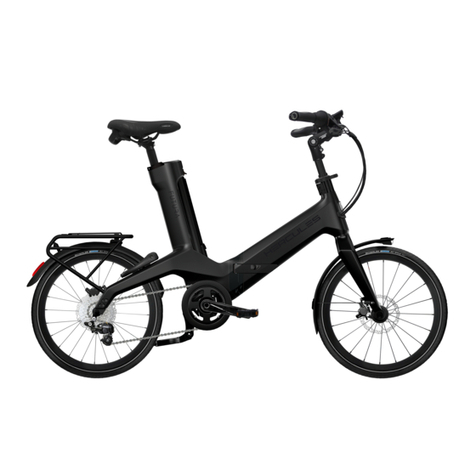
Hercules
Hercules Fazua Futura User manual
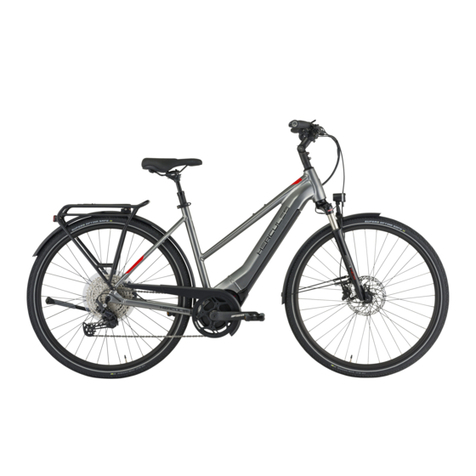
Hercules
Hercules PASERO COMP I-12 Quick guide
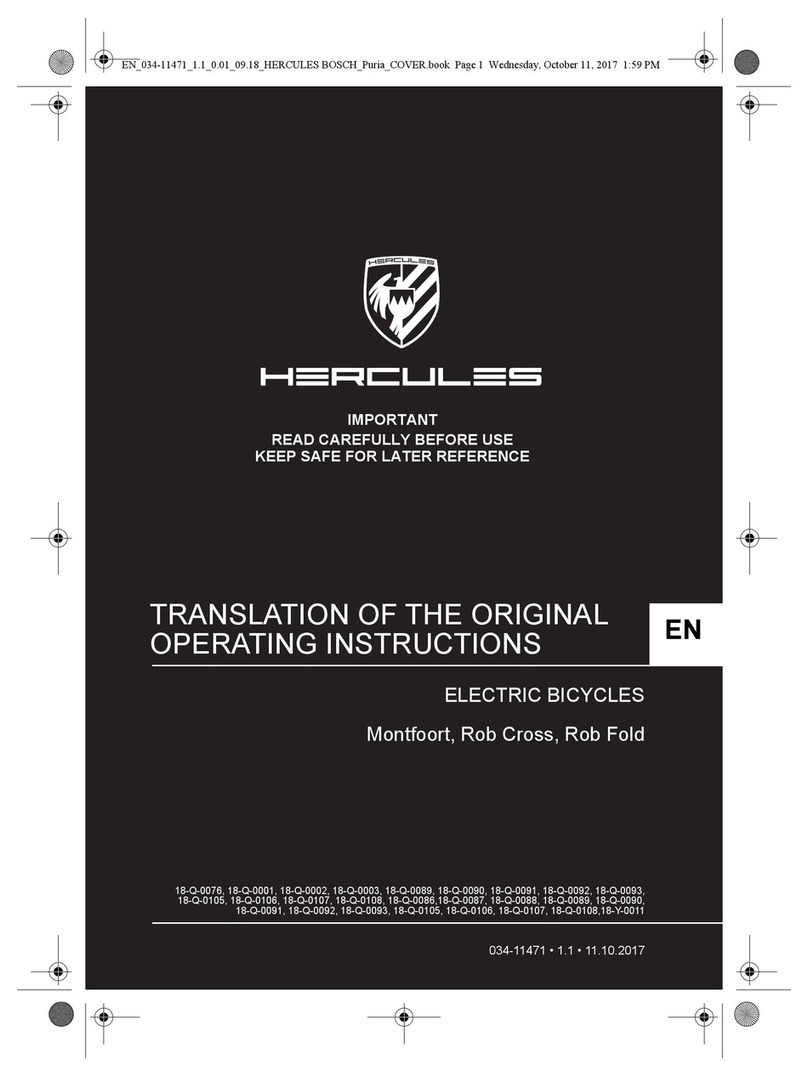
Hercules
Hercules Montfoort Cruise F7 Series User manual
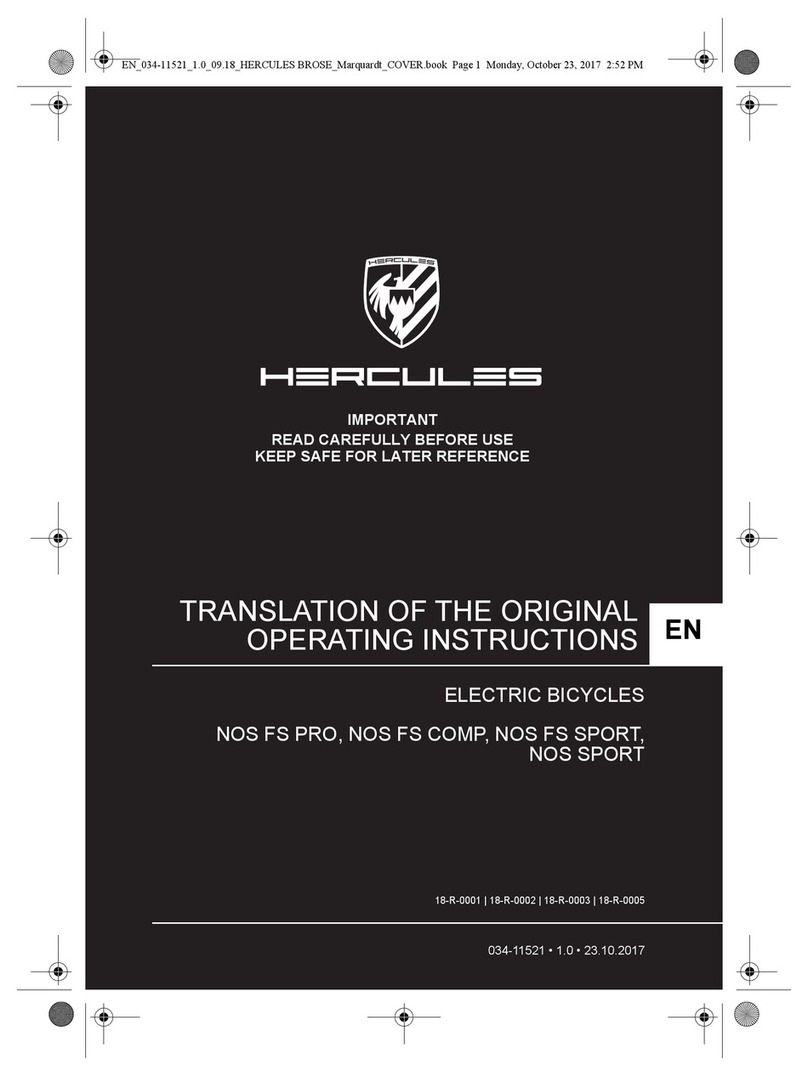
Hercules
Hercules NOS FS PRO Quick guide
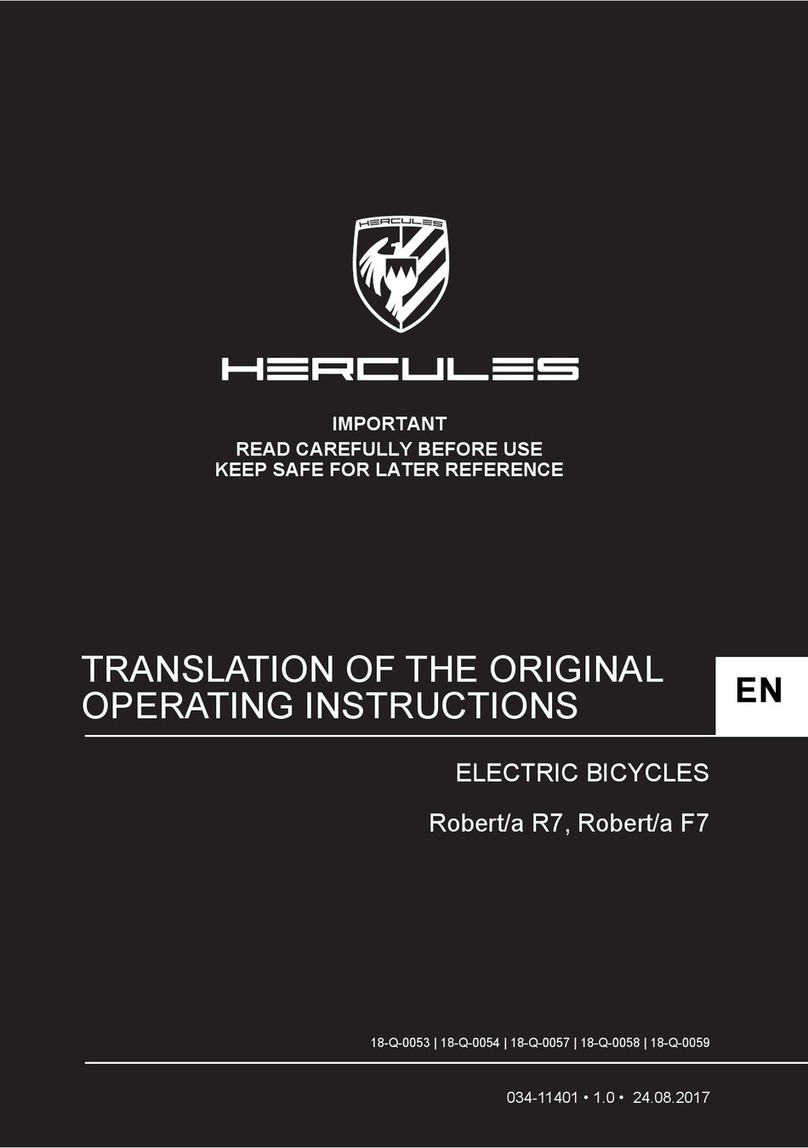
Hercules
Hercules Robert/a R7 Series User manual
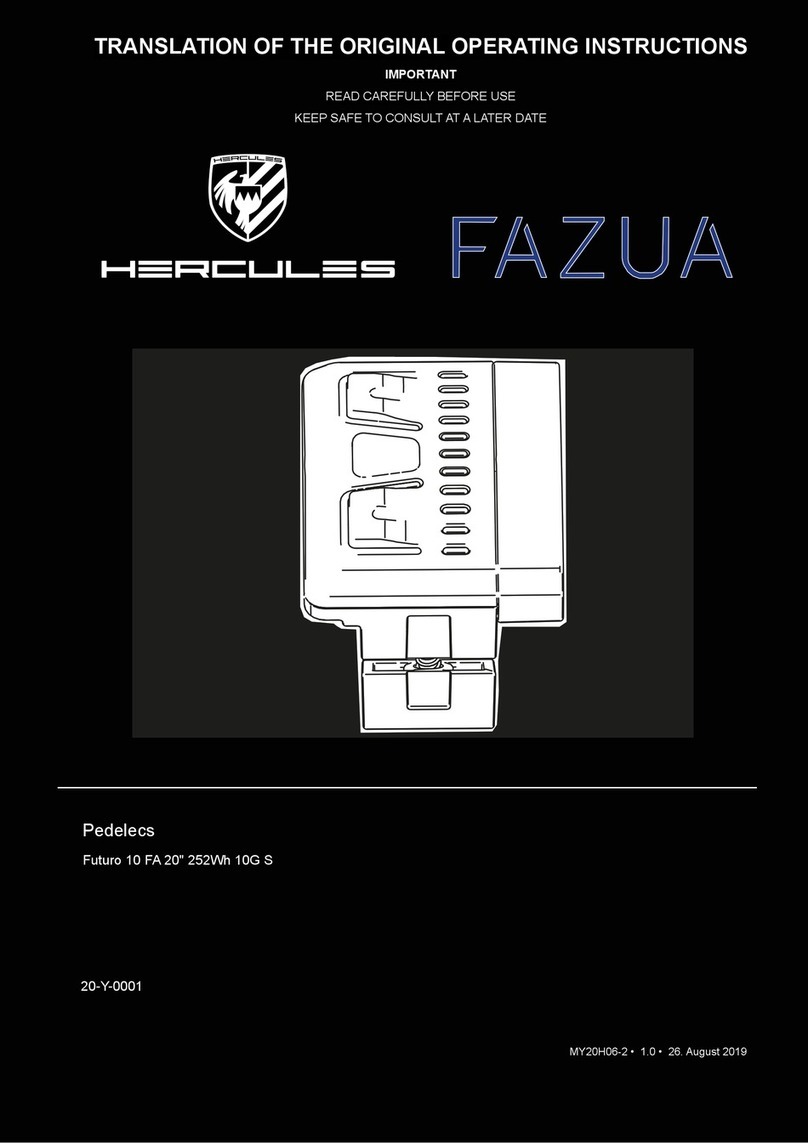
Hercules
Hercules FAZUA Futuro 10 FA 20" 252Wh 10G S Quick guide

